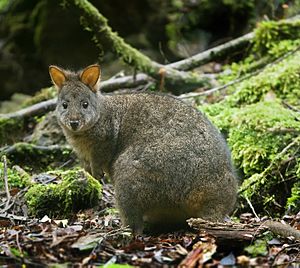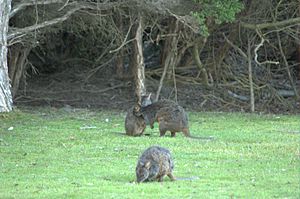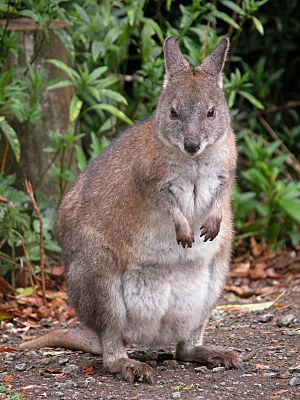Pademelon facts for kids
Quick facts for kids Pademelon |
|
|---|---|
 |
|
| Tasmanian pademelon, Thylogale billardierii | |
| Scientific classification |
|
| Kingdom: | Animalia |
| Phylum: | Chordata |
| Class: | Mammalia |
| Infraclass: | Marsupialia |
| Order: | Diprotodontia |
| Family: | Macropodidae |
| Subfamily: | Macropodinae |
| Genus: | Thylogale Gray, 1837 |
| Type species | |
| Halmaturus (Thylogale) eugenii |
|
| Species | |
|
7, see text |
|
Pademelons are small marsupials, which means they are mammals that carry their babies in a pouch. They belong to a group called Thylogale. These animals are some of the smallest members of the Macropodidae family, which also includes kangaroos and wallabies.
The name "pademelon" comes from the word badimaliyan. This word is from the Dharuk Aboriginal language, spoken by people from the Sydney area in Australia. Pademelons usually live in forests.
Pademelons look a lot like wallabies and kangaroos. The main difference is their size. Pademelons are the smallest of the three. You can also tell them apart by their tails. Pademelons have shorter, thicker tails with less hair. Like wallabies, they move around by hopping.
Contents
Types of Pademelons
There are seven different types, or species, of pademelons. Each one has its own unique features and places where it lives:
- Tasmanian pademelon (also called red-bellied pademelon), Thylogale billardierii
- Brown's pademelon, Thylogale browni
- Dusky pademelon, Thylogale brunii
- Calaby's pademelon, Thylogale calabyi
- Mountain pademelon, Thylogale lanatus
- Red-legged pademelon, Thylogale stigmatica
- Red-necked pademelon, Thylogale thetis
Where Pademelons Live
Pademelons live in different parts of Australia and New Guinea. Their homes are usually in thick forests or dense bushes. They also create tunnels through tall grasses and plants in swampy areas.
Red-necked Pademelons
Red-necked pademelons live along the coast of Queensland and New South Wales in Australia. They can also be found in south-central New Guinea. In some places, there are now much fewer of them than there used to be.
Tasmanian Pademelons
The red-bellied or Tasmanian pademelon is very common in Tasmania. However, they used to live across the southeastern parts of mainland Australia as well.
Dusky Pademelons
The dusky pademelon lives in New Guinea and the islands nearby. It was once known as the Aru Islands wallaby.
Dangers to Pademelons
Pademelons face several threats that can reduce their numbers.
Hunting and Predators
In the past, people hunted pademelons for their meat and soft fur. Today, their populations are also affected by new animals that hunt them. These include wild cats, wild dogs, and red foxes.
In Tasmania, pademelons are still hunted by native predators. These include quolls, Tasmanian devils, and wedge-tailed eagles. Even with these predators, there are many pademelons in Tasmania. Sometimes, their numbers are managed to keep the population healthy.
Habitat Loss and Competition
Clearing land for new homes and farms is a big problem for pademelons. This takes away their natural habitat. Also, the large number of rabbits has caused issues. Rabbits eat the same grasses as pademelons, leaving less food for them. When land is cleared, larger wallabies and kangaroos sometimes move into areas where pademelons used to thrive.
See also
 In Spanish: Pademelones para niños
In Spanish: Pademelones para niños



